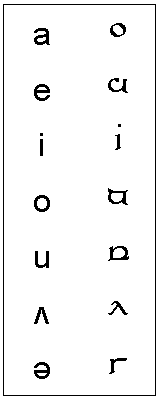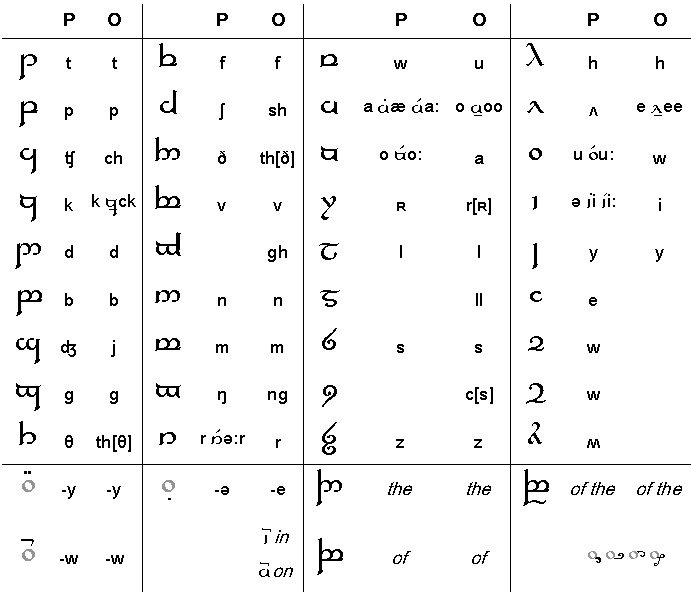© Ronald
Kyrmse
certur @ amonhen . com . br
J.R.R.TOLKIEN'S
FULL
TENGWAR MODES
FOR MODERN
ENGLISH
An
Analysis
TENGWAR
MODES
When
speaking about tengwar, the writing characters created by the Elves, two
kinds of modes may be distinguished: tehta-modes, where vowels are
represented by tehtar, or diacritics above, below and sometimes inside
the tengwar, and full modes, which have a separate tengwa, or character,
for each vowel. The use of diacritics for non-vowel functions, such as
indicating a preceding homorganic nasal or the doubling of consonants, or the
"s-curls" attached to tengwar, does not serve as a distinction between
tehta- and full modes.
Furthermore,
when a tengwa mode is employed for a modern language - as opposed to its use for
Elvish, Black Speech etc. - one must distinguish between phonemic modes,
having ideally one tengwa or tehta for each phoneme of the language, and orthographic
modes, which represent by each tengwa or tehta one graph (written symbol, or
"letter") of the language, or possibly a digraph or trigraph
(fixed combinations of letters, such as English th or ch).
TOLKIEN'S
TENGWAR MODES
This
paper proposes to analyse a limited subset of tengwa-texts, or specimina:
those written by J.R.R.Tolkien's own hand in Modern English, as opposed to those in
languages of Middle-earth or other Mannish languages, such as Old English or
Latin (instances of which do exist), and employing a full mode. Even within
these limits there exist several texts, listed below. Each is designated by a name
for ready reference (thus one may speak of the "Mazarbul-mode" or the
"Bombadil-II-mode") and its DTS number, from the Mellonath
Daeron Index of Tengwar Specimina. The dates attributed to specimina are in
many cases only approximations based on the best educated guesses.
FULL
TENGWAR MODE SPECIMINA
|
Erebor
DTS
1
~1937 |
Inscription
on a jar in Erebor from The Hobbit. Some characters
are obscured. Phonemic.
AnnH
p. 277; P ill. 17; AI ill. 133 |
|
Brogan
DTS
10
~1948 |
A
greeting in a letter to Hugh Brogan. Orthographic.
L
no. 118 |
|
Mazarbul
DTS
13
<=1953 |
The
middle page from the Book of Mazarbul in The Lord of the Rings.
Probably Ori's hand on a badly damaged leaf. Orthographic.
P
ill. 23 |
|
Mazarbul-Final
DTS14
<=1953 |
The
last line of the last inscribed page of the Book of Mazarbul, possibly by
Ori. Orthographic.
P
ill. 23 |
|
Steinborg
DTS
15
???? |
The
title for a drawing of Minas Tirith (called Steinborg by the
Rohirrim) in The Lord of the Rings. The picture in A&I also
shows a crossed-out table of vowels with corresponding tengwar (shown
below). Phonemic.
P
ill. 27; AI ill. 168 |
|
Errantry
DTS
16
~1931 |
A
page of calligraphy with the beginning of the poem "Errantry" -
its third version before being published in the Oxford Magazine. Phonemic.
P
ill. 48 - I |
|
Bombadil
I
DTS
17
~1931 |
A
second specimen of calligraphy showing the beginning of the poem "The
Adventures of Tom Bombadil". Phonemic.
P
ill. 48 - II |
|
Bombadil
II
DTS
18
~1931 |
The
third calligraphic text on the same published page, containing a longer
portion of the beginning of "The Adventures of Tom Bombadil". Phonemic.
P
ill. 48 - III |
|
Ilbereth
DTS
22
1937 |
A
greeting by the Elvish scribe Ilbereth. The tengwar appear to be corrupt
due to faulty reproduction of the thinnest strokes. Phonemic.
FCL
1937 |
|
Leithian
DTS
23
<=1931 |
Several
lines of "The Lay of Leithian". Phonemic.
LB ch. XIII |
|
Treebeard
DTS
24
1939 |
A
commentary on a rejected version of the Treebeard episode in The Lord
of the Rings. Phonemic.
RS ch. XXII |
|
Moria
DTS
25
~1940 |
Three
drafts in the same mode for the inscription on the West Gate of Moria. Phonemic.
RS ch. XXV |
|
Eagles
DTS
28
<1937 |
The
title for a drawing of the coming of the eagles in The Hobbit. Phonemic.
AI
ill. 138 |
|
Letter
II
DTS
45
~1951 |
The
second draft of the King's letter to Samwise Gamgee in the Epilogue to The
Lord of the Rings. Orthographic.
AI
ill. 199 |
|
Letter
I
DTS
48
~1951 |
The
first draft of the King's letter. Orthographic.
SD ch. XI |
|
Letter
III
DTS
49
~1951 |
The
third version of the King's letter. Orthographic.
SD ch. XI |
|
Ring
Draft
DTS53
<=1954 |
Draft version of the Ring-inscription.
Phonemic. |
|
Lord
DTS54
<1955 |
Inscription of the title of The Lord of the
Rings. Phonemic. |
|
Original
Ring
DTS
60
~1938 |
The
original text of the Ring-inscription, difficult to read due to the
extremely cursive nature of the tengwar. Phonemic.
RS ch. XV |
|
Abbreviations: |
AnnH
= The Annotated Hobbit
P
= Pictures by J.R.R.Tolkien
AI
= Artist & Illustrator
FCL
= The Father Christmas Letters
LB
= The Lays of Beleriand, Vol. III of The History of Middle-earth
RS
= The Return of the Shadow, Vol. VI of The History of Middle-earth
SD
= Sauron Defeated, Vol. IX of The History of Middle-earth
|
COMPARISON
AMONG MODES
The
full table shows the usage for each particular
mode, including all tengwar employed, noting also the occurrence of
underposed dot for schwa, superposed double dots for -y and tilde for -w,
abbreviations with extended telcor for the, of, of the, s-curls
and other peculiar uses.
It
should be noted that
-
The
Steinborg specimen is arguably not modern English, but Anglo-Saxon;
-
The
Ilbereth specimen – possibly an example of “Arctic” spelling – is not a genuine
Middle-earth text, and furthermore printed quite indistinctly, so that it
will hardly qualify for an analysis based on letter-shapes.
The
Steinborg- and Ilbereth-texts are therefore excluded from the analysis.
|
It
is interesting to remark that several tengwar always stand for the same phonemic
or orthographic values throughout the chronology. These tengwar -
all for consonants - are shown
in the right-hand table.
The
case for vowels is less clear-cut; for instance, the pencilled and crossed-out table
that accompanies the Steinborg text is shown below. None of the published
modes coincides with it.
|
Common
Consonant Values

|
|
Rejected
Vowels from
Steinborg Drawing

|
There
is considerable variation in the attribution of tengwar to vowels; thus,
for instance, the tengwa anna has variously stood for a, o
and the first vowel in butter. A character looking rather like a
cursive lower-case u
has also been used to designate this latter vowel-sound, but in some cases
this could be considered a mere allograph of anna. |
The
phonemic modes differ in the representation of vowels - as noted above - and the
semivowels y and w. For y the long carrier is used,
sometimes with a dot, sometimes without (this carrier also serves for schwa in
the Treebeard-mode); for w the modes use the tengwa that looks like a
cursive 2
(short or extended); the Ring-mode uses rómen,
more frequently used for r. The aspirated sound in which
(for those speakers that pronounce it differently from witch) is
noted variously as inverted rómen
or hwesta sindarinwa. Use of the
schwa-dot, the tehtar for following y and w and the abbreviations
seems to be common; these graphs are lacking only in those texts where there is no need for
them. The use of one or the other s-curl seems to be dictated partly by
the form of the tengwa to which it is attached.
The
orthographic modes are coincident to a large extent concerning consonants and
vowels, the only notable
differences being the use of rómen
sometimes for r
and sometimes for w.
The modes used for the three versions of the King’s Letter are even more
similar, differing only in the use of lambe
with a tilde inside the bow for ll
in one of them, the forms of the s-curls,
abbreviations for on
and in
(o and i with the nasal tilde) and the peculiar form of
rómen,
looking like an óre with an added bow, in Letter III.
CONCLUSION
Given
these data, it would be idle to ask: "What mode would Tolkien be using
today?", for we can be certain that he would maintain his well-known
"contrasistency", and change modes according to what he judged to be
more adequate at the moment of writing. What we may ask is: "What full
tengwar mode for writing Modern English would Tolkien recognise, upon reading,
as coherent, logically and historically fitting, and above all faithful to the spirit
(if not to the letter - and this word is used advisedly!) of his
sub-creation?". To this each can answer as she or he will; my own opinion
is that we would be faithful to JRRT's most recent practice in employing a
Treebeard-like mode (if writing phonemically) or a Letter-mode (if writing
orthographically). The resulting modes would be similar to those pictured below.
 Certur
Harmatir (Ronald Kyrmse)
Certur
Harmatir (Ronald Kyrmse)
Version
3 - November 2003
The
font employed for practically all tengwar in this analysis is Tengwar
Elfica
PDF
Versions: This Text / Table of
Modes
HOME



 Certur
Harmatir (Ronald Kyrmse)
Certur
Harmatir (Ronald Kyrmse)